A timeline history of first aid, EMS, CPR and lifeguarding
1774 The Royal Humane Society founded to combat ignorance and superstition; investigate and discredit inadequate methods of recuscitating the apparently drowned.
Previous methods, not all of which were discredited, (some of which occasionally worked) included:
using bellows to put air into lungs,
rolling the drowned person on their front over a cask,
putting the drowned person across a horse that was set to a trot,
bleeding,
rubbing with coarse salt,
applying heat (sometimes in the form of hot coals or heated excrement),
tobacco smoke (or sage, rosemary, mint) forced up intestines,
ticking nostrils with a crow feather,
and suspension by the heels.
The first lifesaving societies had to overcome the superstition that it is unlucky to rescue and revive a drowned person.
1776 The Amsterdam Rescue Society was formed and placed fireplace bellows at intervals along Amsterdam’s canals, so people could resuscitate victims pulled from the water during/after drowning.
late 1700s the surgeon-in-chief for Napoleon’s Grand Army, Dominique Jean Larrey, became the first to try to save wounded during battles instead of waiting until the battle was finished
In 1789, the Massachusetts Humane Society began building refuge houses along the Massachusetts coast for shipwreck survivors.
1794 (From the American Red Cross text Life Saving and Water Safety): Artificial respiration “was considered impious and placed nearly upon a level with professing to raise the dead.”
1804 A lifebelt “the Seaman’s friend” invented by W. H. Mallison. It was rejected by the Royal Navy as it
took up too much room and the navy did not want sailors to swim, in case they decided to desert.
In 1807, the the Massachusetts Humane Society set up the nation’s first lifeboat station on Cape Cod.
1852 Congress passed a law that lifejackets, or a float or lifepreserver be required on river passenger steamboats for each passenger.
From a Coast guard website: “… a strong storm swept the East Coast in 1854. Many sailors died because there were not enough lifesaving stations and equipment had not been properly cared for. One town, in fact, used its lifeboat “alternately as a trough for mixing mortar and a tub for scalding hogs.”
1855 According to an Atlantic City museum website, the Atlantic City, New Jersey, city council “appointed William S. Cazier the first constable of the surf.” In those early years the constables donned bathing suits between the hours of eleven and one to be ready to respond to any emergency. With the opening of the Boardwalk in 1872, the first organized volunteer lifeguard service was formed. These brave souls had to pass the hat after each rescue. Not until 1892, did Atlantic City organize a paid beach patrol.”
But the Atlantic City, New Jersey beach patrol says they are the oldest beach patrol in the U.S. and date their start in 1884.
Their site has old beach patrol postcards at:
http://www.acbp.org/postcard.html
April 20, 1861, Clara Barton, the “Angel of the Battlefield,” began aid to servicemen in the U.S. Civil War.
Henry Dunant, a Swiss businessman, having witnessed the wounded left to die alone after the Battle of Solferino, (40,000 men were killed or wounded in a single day), wrote a booklet, A Memory of Solferino, published in 1862, in which he proposed that the States should “formulate some international principle, sanctioned by a convention, inviolate in character, which, once approved and ratified, might serve as the basis for societies for the relief of the wounded” and in which he appealed for relief societies to be formed in the peacetime with nurses who would be ready to care for the wounded in wartime. He also wanted these volunteers to be recognized and protected through an international agreement. Thus the “International Committee for Relief to the Wounded”, which later became the International Committee of the Red Cross, was created.
International feeling against the absence of care for war wounded, grew and the First Geneva Convention convened in 1864. The resulting Treaty of Geneva (“for the Amelioration of the Wounded and Sick in Armed Forces and Field’), thr first treaty of international humanitarian law, was signed by 12 European nations, but not by Great Britain, Saxony, Sweden, or the United States.
The treaty signers agreed that in future wars they would care for all sick and wounded military personnel, regardless of nationality. They would also recognize the neutrality of medical personnel, hospitals and ambulances identified by the emblem of a red cross on a white background.
This First Convention applied to wounded and sick members of the armed forces in the field.
The Second Convention applied to wounded, sick, and shipwrecked members of the armed forces at sea as well as shipwreck victims. The Third Convention applied to prisoners of the war and the Fourth Convention applied to civilians in times of war.
1862 Army Ambulance Corps.
1865 first US civilian ambulance services
1869 Bellevue hospital in New York is the first to actually put doctors on ambulances, along with supplies of bandages, tournquets, a quart of brandy, handcuffs and a straitjacket. Before then hearses were often used and the person deciding if the victim went to the hospital or the morgue was often a funeral director or mortician.
1870 New York City ambulances were dispatched via telegraph
1877 A ‘lifejacket’ made of cork is awarded a patent
1878 W.H. Rideing in Harper’s New Monthly Magazine described a New York City hospital ambulance ride: “A well-kept horse was quickly harnessed to the ambulance; and as the surgeon took his seat behind, having first put on a jaunty uniform cap with gold lettering, the driver sprang to the box…and with a sharp crack of the whip we rolled off the smooth asphalt of the courtyard and into the street…As we swept around corners and dashed over crossings, both doctor and driver kept up a sharp cry of warning to pedestrians.”
Clara Barton, who heard about the International Red Cross movement while in Europe after the Civil war, founded the American Red Cross in Washington, D.C. on May 21, 1881.
Clara Barton also worked for United States ratification of the first Geneva Convention. On March 1, 1882, President Chester A. Arthur signed the treaty. The Senate ratified it on March 16, 1882 and the United States became the 32nd nation to sign the document.
House Surgeon A.B. Miles wrote in the June 1885 edition of the New Orleans Medical and Surgical Journal about new horse drawn ambulances for the Charity Hospital, New Orleans, with “fourteen Resident Students charged with the special duty of Ambulance Surgeons.”
“This service was organized to meet a demand. … Since the erection of the Hospital in 1832, the sick and injured have been brought to the door in vehicles of every conceivable kind… Many patients suffered discomfort merely, while others sustained injuries prejudicial to their after-treatment. Some … must have succumbed to the delay and ill usage incident to such hap-hazard transportation.”
Ambulances could be dispatched within three minutes from a call and had “right of way over all vehicles except those of the fire department and the United States Mail…In answering calls, the ambulance corps move with all possible dispatch. The efficiency so far attained is due in a large measure to the competency of the staff of Resident Students of the Hospital, and the zeal with which they discharge their special duty… Each ambulance was stocked with antidotes and stimulants most serviceable in emergencies: Chloroform, sulphuric ether, whisky, brandy, carbolic acid, olive oil … hypodermic tablets and syringe, water…and one gallon of an oil which made a dressing quickly and easily applied in the emergency of burns and scalds…The surgical outfit included a complete pocket case of instruments … tourniquets, folding fracture box, long splints, wooden and tin splints (for extremity fractures), bandages, carbolized gauze, cotton padding, pillows, surgeon’s lint, sponges, tracheotomy tube, a catheter, pus pans, water buckets, etc.”
Read an article about the Point Reyes Lighthouse from the San Francisco Chronicle Sept. 25, 1887 “There is not, from Mexico to Oregon a more forbidding or dangerous coast line than that extending from Point Reyes to Tomales bay. It is made doubly dangerous by its proximity to the harbor of San Francisco, many a vessel having gone ashore under full sail believing that it was headed for the Golden Gate.” http://www.nps.gov/pore/historyculture/people_maritime_sfchroniclearticle.htm
1891 two members of the Amateur Swimming Association of Great Britain formed the Swimmers Life-Saving Society, later to become the Royal Life Saving Society.
1894 (From the American Red Cross text Life Saving and Water Safety):
” No one should employ the more spectacular forms of rescue, if less perilous methods may be used just as effectively.
Sinclair and Henry in their book on Swimming published as part of the Badminton Library in 1894 recount a tale of heroism which aptly proves a point. The tale is much too long to be quoted in full here but its substance is this: A boat load of mill workers were being ferried across the Clyde one evening. The boat was badly overloaded and had not proceeded twenty yards from the dock, when it listed suddenly and overturned. One James Lambert, a powerful swimmer by the record and a good waterman, found himself in the water gripped about by as many men and women as could lay hands in him while others held to them. With marvelous self-possession and cold courage he allowed himself to sink to the bottom with his burden and found the water to be about ten feet deep. Being quite unable to swim because of the manner in which he was held down he, nevertheless, contrived to get his feet down and shove diagonally to the surface and some few feet toward the dock before he sank again. Thus alternately driving off the bottom, getting a breath of air and sinking again he managed to near the dock where ropes and boathooks were used to relieve him of his burden. Upon checking it was found that he had brought in sixteen or seventeen of the unfortunates but he did not rest there. Plunging in again and yet once more he brought to shore first, two girls and then another girl and her young man, who were drowning together. Then, and this is the irony of it, he found himself clinging to the quay so spent that he would inevitably have sunk and drowned if an old and decrepit man had not seen him and, extending his cane to him, towed him along the quay to shallow water and helped him out. Thus the most spectacular rescue of all time would have ended tragically for the hero, if the old man had not used effectively, if not as spectacularly, the only means at hand commensurate with his strength and ability. The story points its own moral.”
1897 the first rescue can, made of sheet metal and pointed at both ends with an over-the-shoulder harness, replaces life rings towed by lifeguards. It slides faster through the water but the type of construction causes injuries.
1899 Pennysylvania miners form a group to “take up the study and practice of first aid.”
1901 Stereograph showing “beach goers, in swimsuits, wading in the water by holding onto ropes”
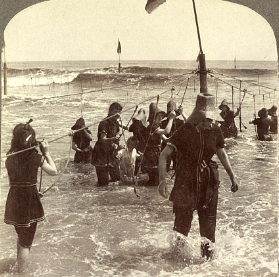
1903 English doctor E Sharpey Schafer invented a method of prone pressure artificial respiration.
1908 George Douglas Freeth established the first lifeguard training at Redondo Beach, California.
1910 First Aid training introduced as a national Red Cross program
1912 At the age of seven, LeRoy Columbo suffered an attack of spinal meningitis which cost him his hearing and the use of both legs. He tried swimming (and his three brothers worked with him) and within a year he was able to walk again.
He eventually became the first deaf lifeguard as well as earning the title “the World’s Greatest Lifeguard.” He saved 907 lives in a 40 year career, a record noted in the Guinness Book of World Records.
In 1923 he became the first deaf person to join Galveston’s elite “Surf Toboggan Club.” He qualified by swimming continuously for three hours with no stops or floating. And in 1923 he became a lifeguard for the city of Galveston.
LeRoy made his first rescue (of a drowning boy) at the age of 12. In 1928 he rescued two crewmen after a tugboat exploded in flames (this required swimming beneath burning oil).
LeRoy almost drowned 16 times during rescues.
He retired at 62 and continued to swim in the ocean daily until he died on July 12, 1974. Flags in Texas were flown at half staff upon his death and a plaque was erected on the Galveston beach he patrolled for forty years.
1912, the National YMCA Lifesaving Service was organized
1913 George Goss wrote a thesis at Springfield College which was eventually published as a lifesaving textbook in 1916. It was first promoted as “Water First Aid.”
1914 Former journalist Wilbert E Longfellow helped start Red Cross water safety instruction and the Red Cross Life Saving Corps to combat the climbing number of drownings. His main objective was to organize local volunteers into lifesaving corps.
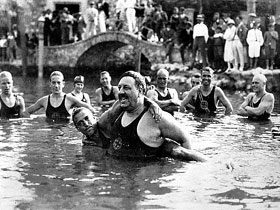 His slogan: “everyone a swimmer, every swimmer a lifesaver.”
His slogan: “everyone a swimmer, every swimmer a lifesaver.”
The lifesaving service required that a candidate be able to swim 50 feet.
1916 requirements for lifesavers:
“must be able to tow a person of their own weight ten yards by each of the following methods: (a) head carry, using two arms and swimming on back; (b) under-arm carry, using two hands and swimming on back; (c) cross-chest carry, using one arm and side stroke; (d) using breastroke, hands of rescued on shoulders.
They must be able to show in the water three methods of releasing themselves from people in peril of drowning when grasped by: (a) wrist hold), (b) front neck hold, (c) back hold.”
They are required to demonstrate both the Schafer and Silvester methods of performing artificial respiration, although the Schafer method is the one preferred. (No mouth to mouth contact in rescue breathing. In one style, people were put on their stomachs and their arms were raised overhead or their shoulders pulled up to get air into the lungs.)
1918 from the CDC (Centers for Disease Control and Prevention):
“In 1918, 13 people drowned in rip currents in a single day at San Diego’s Ocean Beach, garnering local and national news attention. Beach attendance that day was estimated at 5,000. City officials cited inadequate lifeguard protection as a cause of the tragedy, and as a result, initiated a municipal lifeguard service. The ocean conditions have changed little since then. San Diego’s local leaders view the 17 miles of oceanfront shoreline, which include Ocean Beach, as a safely managed tourist attraction due to the presence of lifeguards. Despite an average estimated annual attendance of 15 million people and over 7,000 rescues at the major lifeguarded beaches, the average number of drownings in areas under lifeguard protection is between zero and one annually.”
Six cardiologists founded the American Heart Association in 1924.
When Duke Paoa Kahanamoku of Hawaii (1890 – 1968), the father of surfing, inventor of the rescue board, six time Olympic gold medalist and winner of the Olympic 100 meter race in 1912 and 1920, using a six-beat kick, with his size 13 feet, was asked who taught him the crawl stroke, he said “no one.” He had been swimming a stroke he saw older natives of his island swim. He kept his records until he was 34, when 20 year old Johnny Weissmuller (who eventually set 51 world records and became Tarzan of the movies) beat him in the 1924 Paris Olympics.
Kahanamoku became the first person inducted into both the swimming and surfing halls of fame. In 1925 he rescued eight people from a overturned fishing boat, using only a surfboard. Of the 29 people on board the Thelma when it overturned in very rough seas, only 12 were rescued.
Later he said:
“In that instant my knees went to tallow, for a mountain of solid green water curled down upon the vessel. Spume geysered up in all directions, and everything was exploding water for longer than you would believe. Then, before the next mammoth breaker could blot out the view again, it was obvious that the Thelma had capsized and thrown her passengers into the boiling sea. Neither I nor my pals were thinking heroics; we were simply running — me with a board, and the others to get their boards — and hoping we could save lives… I hit the water hard and flat with all the forward thrust I could generate, for those bobbing heads in the water could not remain long above the surface of that churning surge. Fully clothed persons have little chance in a wild sea like that, and even the several who were clinging to the slick hull of the overturned boat could not last long under the pounding… It was some surf to try and push through! But I gave it all I had, paddling until my arms begged for mercy. I fought each towering breaker that threatened to heave me clear back onto the beach, and some of the combers almost creamed me for good… Don’t ask me how I made it, for it was just one long nightmare of trying to shove through what looked like a low Niagara Falls. The prospects for picking up victims looked impossible. Arm-weary, I got into that area of screaming, gagging victims, and began grabbing at frantic hands, thrashing legs.”
1920 Young Ladies Institute Life Saving Corps
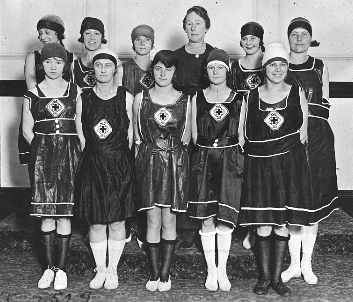
1930 the first use of the motto of Royal Life Saving Society Canada:
Quemcunque Miserum Videris Hominem Scias…Whomsoever you see in distress, recognize in him a fellow man.
1933 Fins “Lifesaving and Swimming Propelling Device” patented by Louis de Corlieu.
1935 Danish Colonel Holger Neilson’s method of artificial respiration was easier to learn and perform and got better air exchange
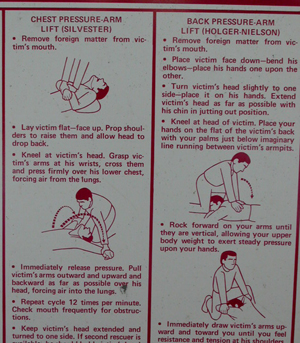
Read more about Pete Peterson at:
http://www.legendarysurfers.com/2011/01/1930s-pete-peterson-1.html
1937 the Red Cross text for lifesavers, Life Saving and Water safety, is published, replacing a booklet, Life Saving Methods. The new text “an authoritative source of knowledge and information,” had no pictures of women rescuers. Requirements for lifeguard candidates: (as of copyright 1937, 1956). “A swimmer who wishes to undertake swimming rescue training must have reasonable water ability as a preliminary requirement. He should be able to make a shallow dive in good form, swim a quarter of a mile without resting or keep afloat by treading water and swimming in place for a period of ten minutes…He should, of course, be capable of making a surface dive and of swimming a short distance underwater.”
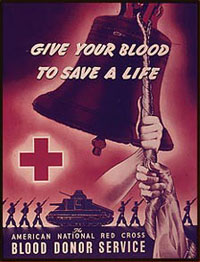 During WW ll, 1939 to 1945, the Red Cross started a national blood program that collected 13.3 million pints of blood for armed forces. After the war the Red Cross started the first nationwide civilian blood program.
During WW ll, 1939 to 1945, the Red Cross started a national blood program that collected 13.3 million pints of blood for armed forces. After the war the Red Cross started the first nationwide civilian blood program.
1938 first auto seat belts

1940 the precursor to the bag valve mask: “Life-giving air is forced into the lungs of a patient by a hand-powered pump developed by a Swiss doctor, who expects it to be useful in treating soldiers after poison-gas attacks. The plunger pump forces air or oxygen through a tube leading to a mask held over the mouth of the patient.” quoted from Popular Science magazine, July 1940
August 2, 1943 at about 2 a.m. the Japanese destroyer Amagiri hit PT 109 and killed two of
John F. Kennedy’s crew. He helped rescue his crew members and by dawn they were floating on the bow.
That day they swam and helped each other swim to an island. Kennedy helped the man most injured, towing the sailor’s life vest with his teeth.
He had been on the first Harvard swim team to beat Yale. The Harvard Guide says “Too small to play intercollegiate football, he joined the swim team. He’s remembered by the coach as “a fine kid, frail and not too strong, but always giving it everything he had.”
In 1947 the U.S. drowning rate (5.2 per 100,000 people) was cut in half from that of 1914 (10.4 per 100,000 people).
The Colorado Mountain Club starts a technical climbing school with mountaineering first aid lessons.
1949 James Elam, an anesthesiologist, who had been reading historical accounts of new borns being resuscitated with mouth to mouth breathing, tried during a hospital emergency to inflate the lungs of a young boy and it worked.
1953 the first Australian lifesaving manual. Previous manuals were “heavily orientated to a military drill-type approach.”
A 1956 printing of American Red Cross Life Saving and Water Safety says, in part:
“Grappling irons should be considered not only as body recovery but as rescue devices, since the first few casts of the irons may bring a victim to the surface in water too deep for diving and in time to use artificial respiration successfully.”
1956 MedicAlert® is “a nonprofit membership organization founded in 1956,” as a information repository that “can connect to and provide critical medical information between patients, providers, payers, and first responders 24 hours a day anywhere in the world… The MedicAlert® repository uses Web service interfaces to support standard Personal Health Records (PHRs), including electronic drug prescriptions and for patient record interoperability.”
Dr. Peter Safar, known as the Father of CPR, says the seeds were sown for the A (airway) and B (breathing) steps of CPR during a two-day car trip in October 1956, returning from a medical convention and talking shop with Dr. James Elam (see 1949).
In the late 1950s Safar worked with Martin McMahon, chief of the Baltimore Fire Department ambulance service to design the first modern ambulance. At that time ill people were taken to hospitals in station wagons (or even hearses), with no care given on the way. Safar and McMahon designed an ambulance as we know it today, with a large compartment for a patient bed and seating for an attendant who could give oxygen and had equipment at hand to insert airways.
1957 the U.S. Military adopts mouth to mouth breathing
1958 the American Medical Assn endorses mouth to mouth breathing
In 1960 the Royal Lifesaving Society is the first to teach mouth-to-mouth, direct contact resuscitation instead of methods which use back pressure or arm lifts.
1960 Dr. Peter Safar approached Norwegian toymaker Asmund Laerdal to develop a realistic life-sized mannequin for teaching mouth-to-mouth resuscitation. The manikin’s face was inspired by a death mask, owned by Laerdal, of a girl who drowned herself in the Seine River.
Safar developed the first U.S. intensive care unit and paramedic ambulance service, and was nominated three times for the Nobel Prize in medicine
He wrote to U.S. presidents with his opinion on world problems (as well as science), including the U.S. war with Iraq. He helped found Physicians for Social Responsibility and the International Physicians for the Prevention of Nuclear War.
See Peter’s Laws for the Navigation of Life, quoted at the bottom of this page.
During a 1964 lifeguard competition at Huntington Beach, lifeguards Mike Henry and Pete Orth of Carpenteria, California, collided with the Huntington Beach pier after their dory went out of control on a ten foot wave. ABC television’s Wide World of Sports filmed this moment and replayed it over and over again as one of the ‘Great Moments’ of the year.
1964 Pete Peterson designs a rescue tube made from foam rubber hot dipped in a rubber coating. See also the original rescue tube, 1935.
1965 the first version of portable defibrillator, invented by Frank Pantridge (the “Father of Emergency Medicine”) was installed in a Belfast, Northern Ireland ambulance. (From Wikipedia) “It weighed 70 kg and operated from car batteries, but by 1968 he had designed an instrument weighing only 3 kg, incorporating a miniature capacitor manufactured for NASA.”
late 1960s to 1975During the Vietnam War, because of trained
medical corpsmen, rapid transportation and advanced trauma care, a wounded soldier had more chance of survival than a serious motor vehicle accident victim in California.
1965 more deaths from motor vehicle accidents than lost in the Korean war.
In 1967, a presidential commission on law enforcement recommended that a single phone number to be used across the country for fire, police and medical emergencies.
Jan. 10, 1967 a newspaper helicopter was used to transfer a prematurely delivered infant from one hospital to another in Illinois. The baby was held in a small box on the lap of a Sister from the Third Order of Saint Francis.
In 1968, A police station in Haleyville, Alabama is the first to use 9-1-1 as the three-digit number for fire, police and medical emergencies. The United Kingdom had first used a universal number (999) in 1937. In 1961 Australia used (111) and Canada used (999) in 1959. Supposedly 911 was chosen over 999 in the U.S. because it was easier/faster to dial on a rotary phone. In the late 70s a few other cities/counties had enhanced 911 systems. President Clinton signed Senate Bill 800 designating 911 as the nationwide number on October 16, 1999. At that time there were 20 different wireless numbers in different states.
1970 Military helicopters are used to move critically ill victims from remote areas to hospitals. Pilots included Vietnam veterans, a few of whom showed off their flying skills by flying under bridges and buzzing neighborhood swimming pools.
A 1982 printing of American Red Cross Lifesaving Rescue and Water Safety, says in part: “If a person is in danger of drowning only a short distance from shore and there is no rescue equipment of any kind available, the untrained swimmer may feel that is it necessary to attempt the rescue. In such cases, the rescuer should swim to a position behind the victim and make contact with the victim by seizing the person’s hair.”
Lifeguard certification cards (advanced lifesaving and water safety) featured a drawing of the silhouettes of a man dragging a buxom female victim through the water on her back by her hair.
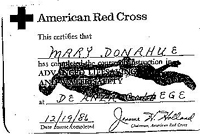
1988 A National Park Service management policy states “the saving of human life will take precedence over all other management activities.”
1989 from the CDC (Centers for Disease Control and Prevention):
“the Nassau County Commission decided to eliminate lifeguards on American Beach in order to save county expenses. Less than a year later on Memorial Day, 1990, five persons drowned and 20 others nearly drowned when rough ocean conditions and strong winds caused rip currents to form immediately offshore, making this one of the worst drowning episodes in Florida’s history. Shortly after this tragedy, local officials reestablished lifeguarding services. In the eight years since, no one has drowned.”
1989-2001 Baywatch soap opera
It wasn’t just an urban rumor. There has been hair entanglement, entrapment associated with spas:
https://en.wikipedia.org/wiki/Virginia_Graeme_Baker_Pool_and_Spa_Safety_Act
1990 The Lancet reports that in 1990 worldwide death by drowning (504,000) was more common than death through war (502,000).
_________________________________________
two Red Cross lifeguard recruitment posters

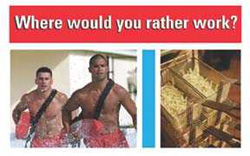
_________________________________________
July 29, 1991 112 becomes the emergency number for the European Union, from Iceland to Turkey.
1992 American Red Cross booklet Waddles Presents Aquacktic Safety tells the tale of a duck character, Waddles, going to his first swim lesson. His instructor is a pink Flamingo named Miss Pink, and the lifeguard is a gorilla whose rescue tube is hanging on the wall, not with him as he sits in the stand.
1992 from the CDC National Center for Injury Prevention and Control :
“Keawaula Beach at Kaena Point State Park is located at the westernmost point on the island of Oahu. The beach is exposed to high surf; a strong shore break; and a strong, often severe, current. The remote, pristine site attracts many surfers, sunbathers, swimmers, and waders. The combination of dangerous physical features and heavy use by patrons increases the risk for water-related injury and death. From 1985 to 1991, two drownings and 40 near-drownings occurred at Keawaula Beach. Although the State of Hawaii does not provide lifeguards, it elected to contract with the City and County of Honolulu to place lifeguards at Keawaula Beach beginning in January, 1992. Since then, no drownings have occurred at this beach.”
A 1994 study, one of the largest of it’s kind, found that less than 2 percent of New Yorkers with out-of-the-hospital heart attacks survived. Guy Lombardi, who started as one of the New York Fire Department’s (NYFD) first paramedics, went on to become a doctor and eventually a FDNY physician, is credited with using this research he co-authored as a catalyst for allowing not only paramedics, but also police officers, to be trained to use defibrillators.
1999 The Red Cross includes automated external defibrillator (AED) training in CPR courses.
In June, 1999, Chicago’s O’Hare Airport installed AEDs, located so that an AED was within one minute walking distance of anywhere in the airport. In the first ten months 14 cardiac arrests occurred and nine of the victims survived. That’s a 64% survival rate, compared to 3% – 4% with CPR alone.
2001 QuikClot, a granulated mineral coagulant was developed, used by the U.S. military to treat serious wounds.
Global positioning systems are first used in ambulances, sometimes leading them off course and causing them to arrive minutes or even hours late.
At the Labor Day, 2003, 2.38-mile Waikiki Roughwater Swim, less than 40 percent of the swimmers finished. “Of over 1,000 swimmers who started the race, a mere 356 finished. More than 600 were rescued by eight units of the Honolulu Fire Department, including its helicopter unit. The Coast Guard also joined in the rescue operation with a helicopter and boats and private boaters in the area pulled several swimmers out of the water,” according to Swim Info. One source put the cost for the Coast Guard alone at $31,000.
A summer of 2003 study of drowning in France found, (of 781 rescues followed by hospitalization or fatality),
44% in the ocean (56% of victims older than 45 years of age)
25% in swimming pools (61% in private pools)
15% in lakes (25% between the ages of 25 and 44)
12% in rivers (28% between the age of 25 and 44).
Of the 781 drownings, 41% were fatal.
from the Coast guard: in 2004, States and jurisdictions reported a total of 12,781,476 registered recreational boats compared to 12,794,616 in 2003. The 4,904 boating accidents reported in 2004 resulted in 676 fatalities, 3,363 injuries, and $35,038,306 in property damage.
.. Approximately seventy percent of all fatal boating accident victims drowned (484 out of 676). Approximately 90 percent of the victims who drowned were not wearing their personal flotation device (PFD or lifejacket). Overall, fatal accident data show approximately 431 lives could have been saved last year if boaters had worn their lifejackets.
Approximately 70% of all reported fatalities occurred on boats where the operator had not received boating safety instruction.
.. Alcohol was involved in approximately one-third of all boating fatalities in 2004.
In 2004, there were 3,308 unintentional fatal drownings in the United States, averaging nine people per day. This figure does not include the 676 fatalities, from drowning and other causes, due to boating-related incidents (CDC 2006; USCG 2006). For every child 14 years and younger who died from drowning in 2004, five received emergency department care for nonfatal submersion injuries. (CDC 2006).
Access Cardiosystems, Inc. issued a Worldwide Recall of its AEDs in November 2004 due to the “ON/OFF” button and the shock delivery ciruit failing to function as well as the AED possibly turning on suddenly.
Circa 2005 cell phones are used by EMTs/Paramedics in ambulances to transmit patient’s EKG readings more quickly to doctors in the emergency room, great except for dropped calls.
According to the Red Cross, in late 2006, “In Santa Clara County, for example, the average emergency response time from the call to 911 to arrival is about 7 minutes. (Times may vary due in part to traffic delays and the logistics of getting to victims in high-rise buildings.) ”
For every minute that slips by without defibrillation, the victim’s chance of survival falls by about 10 percent. See also:Do AEDs work?
May 28, 2007 Heavy surf broke the usual sandbars at beaches in Florida and hundreds of swimmers were rescued at one beach between noon and 3 p.m., before the beach was closed.
In 2008 there were 50 drowning deaths in all of Australia, but in Bangladesh 50 children drowned each day of the year. This is not just due to the larger population in Bangladesh, the rate was 21 times higher there than in Australia. Drownings occur in natural bodies of water, in rice farming, where livestock are being watered in the family compound and in large cooking vessels.
June, 2009 The Lifesaving Society, Canada, found that in the most recent year in which data about drowning became available, “the annual drowning toll in Canada has spiked.” 433 had been recorded in 2004, up to 492 in 2005. Drowning remains the third leading cause of death among Canadians under 60 years of age and the second leading cause of death for children under the age of 10. Men are four times more likely to drown than women. 90% of people who drown while boating were found not wearing a lifejacket and alcohol was involved in about one third of the drowning deaths.
The World Conference on Drowning Prevention 2011 says that the global burden of drowning, in everyday life, recreation and disasters, is estimated to range from over 400,000 to 1 million people every year. ” Children, particularly those aged 1 to 4 years, carry the overwhelming burden of drowning in high, middle and low income countries.”
An April 2011 Red Cross survey found that about a third of adults do not realize that close supervision — staying within arm’s reach — is safer than putting floaties or water wings on a small child in a pool.
Sept. 2012
From an article in Aquatics International
“Tomas Lopez, 21, was dismissed for vacating his lifeguarding zone to save a man drowning in an unguarded area of the beach in Hallandale Beach, Fla. According to reports, Lopez made the rescue after he was approached by a beachgoer who pointed out a man struggling in the water nearly 1,500 feet south of his post. . . . Six guards quit over the episode, and the story was picked up in both national and international media. . .
“I have read three different news stories about this incident … and in each of them it is mentioned that Lopez secured backup at his beach before venturing out to make the save.”
2015 The American heart Assn. reports that laypersons should be trained in hands-only (compressions only, no rescue breathing) CPR, as well as full CPR.
http://circ.ahajournals.org/content/circulationaha/early/2015/06/30/CIR.0000000000000233.full.pdf
2017 Cruise ship lines (Disney and Royal Caribbean) institute fleetwide lifeguarding of ship pools.
2017 Because of better sound insulation in cars, crashes involving drivers who didn’t hear sirens are becoming more common. Swedish ambulances are experimenting with technology to interrupt radio transmissions on the FM band with a warning that they are approaching, giving motorists more time to get out of the way.
A 2018 report from the Canadian Red Cross said that:
“Canadian Red Cross’ ongoing surveillance of unintentional water-related fatalities tracked 398 snowmobile-related deaths over a period of 20 years and found that snowmobile immersion deaths were largely preventable.
The major risk group for snowmobile immersion deaths was 15- to 44-year-old males, with the largest number of deaths occurring among 25- to 34-year-olds.
Snowmobiling immersion incidents occurred while riders were travelling on ice, going off-road or off bridges, and 59% of incidents occurred on lakes.
Alcohol was present or suspected for 58% of fatalities 15 years of age and older (blood alcohol content was above the legal limit for 37%, below the limit for 12%, and suspected for 9%).
Only 3% of people who died in snowmobiling incidents were properly wearing a flotation device such as a lifejacket or survival suit.
Other immersion deaths involving motor vehicles on ice include ATV’s and ice fishing using a road vehicle.
Among deaths from immersion while on ice, 46% resulted from open holes in the ice, and 42% from falling through thin ice.”
A report from July 30, 2018 In Africa, “After Malaria and malnutrition, drowning is the cause of more deaths than any other. Although a relatively rare occurrence, aircraft incidents involving fatalities make headline news across the world, yet an overturned canoe resulting in just as many deaths does not.”
https://www.international-maritime-rescue.org/news/slowing-africas-silent-killer
Summer of 2019
From an article in Aquatics International:
Summer of 2019 “saw a slight increase in the number of children under 15 who fatally drowned in a U.S. pool or spa.
At least 150 children in that age bracket died in U.S. pools and spas, according to the USA Swimming Foundation and the Consumer Product Safety Commission, which collaborate in CPSC’s Pool Safely campaign.
“Texas saw the most reported pool/spa drownings of children under 15, with 26 occurring this summer. Other states with a high number of incidents included Ohio (11), Florida (10), California (10), Pennsylvania (8), Arizona (7) and Georgia (7).”
The Los Angeles Times reported in 2022:
“Each year, there are about 3,960 fatal drownings in the United States, or about 11 drownings per day, according to the Centers for Disease Control and Prevention. Fatal and nonfatal drownings in pools remain particularly high so far this year, according to a report from the U.S. Consumer Product Safety Commission.”
The May 2022 U.S. Consumer Product Safety Commission report is at:
This chart from the report shows the percentages of drowning at public pools compared to homes:
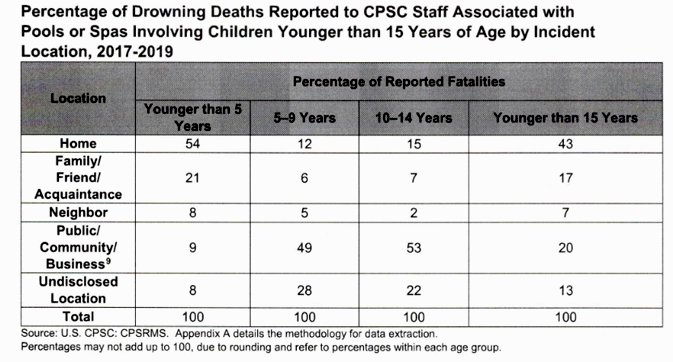
A Centers For Disease Control (CDC) report in May 2024 said that “Approximately 4,000 unintentional drowning deaths occur annually in the United States, and demographic disparities exist . . . 55% of U.S. adults have never taken a swimming lesson . . .”
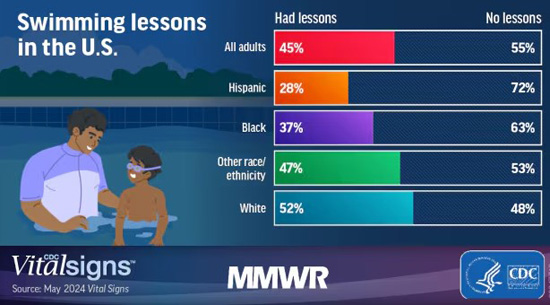
_________________________________________
see also: History of swimming section
Two thirds of drowning victims are good swimmers. Why you should wear a lifejacket.
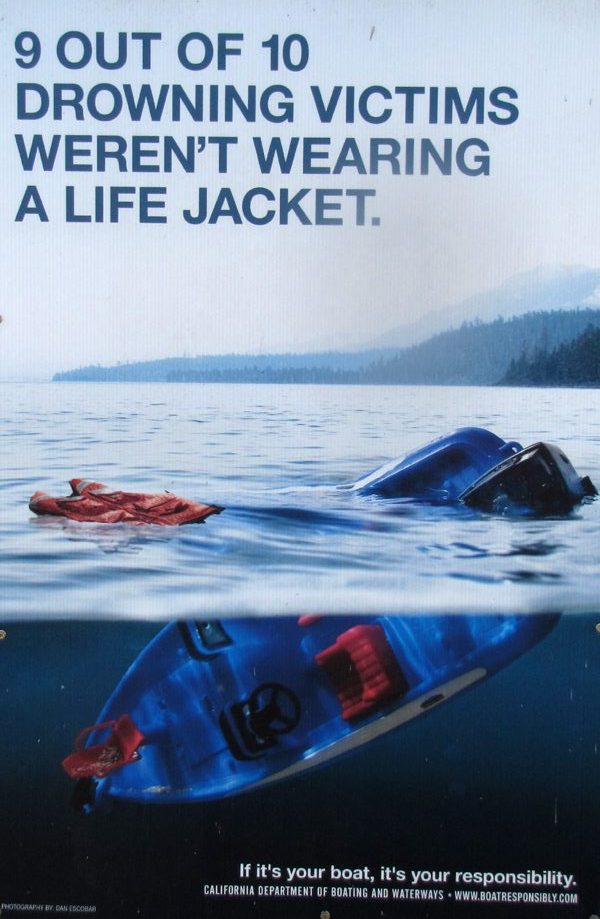
_________________________________________
Peter’s Laws for the Navigation of Life,
(Dr. Peter Safar, see 1950’s and 1960 above),
subtitled
The Creed of the Sociopathic Obsessive Compulsive:
1. If anything can go wrong, fix it!
2. When given a choice, take both.
3. Multiple projects lead to multiple successes.
4. Start at the top and work your way up.
5. Do it by the book… but be the author.
6. When forced to compromise, ask for more.
7. If you can’t beat them, join them, and then beat them.
8. If it’s worth doing, it’s got to be done now!
9. If you can’t win, change the rules.
10. If you can’t change the rules, then ignore them.
11. Perfection is not optional.
12. When faced without a challenge, make one.
13. “No” simply means begin again at one level higher.
14. Don’t walk when you can run.
15. Bureaucracy is a challenge to be conquered with a righteous attitude, a tolerance for stupidity, and a bulldozer when necessary.
16. When in doubt, THINK!
17. Patience is a virtue, but persistence to the point of success is a blessing.
18. The squeaky wheel gets replaced.
19. The faster you move, the slower time passes, the longer you live!
20. Death is not the enemy but occasionally needs help with timing
21: When on thin ice, dance.
22: It’s up to us to save the world